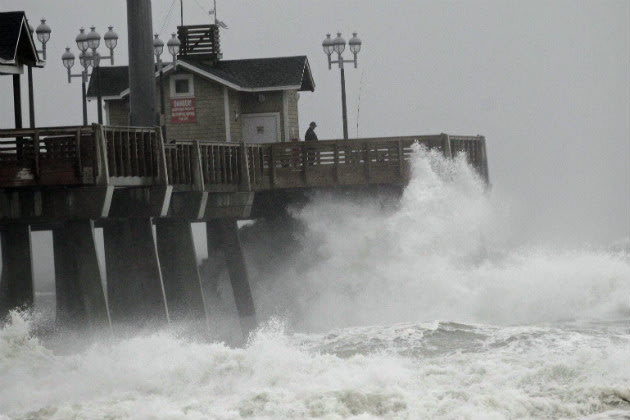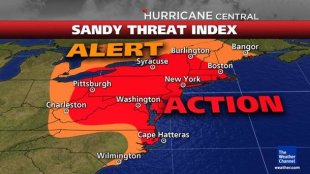 Waves crash into a pier in Nags Head, N.C., Oct. 27, 2012. (Gerry Broome/AP)
Waves crash into a pier in Nags Head, N.C., Oct. 27, 2012. (Gerry Broome/AP)
"Superstorm." "The Perfect Storm." "Frankenstorm."
Whatever you want to call it, the East Coast is bracing for Hurricane Sandy, an epic, "rare hybrid storm" that is expected to bring a life-threatening storm surge to the mid-Atlantic coast, Long Island Sound and New York harbor, forecasters say, with winds expected to be at or near hurricane force when it makes landfall sometime on Monday.
According to the National Hurricane Center, the Category 1 storm was centered about 260 miles southeast of Cape Hatteras, N.C., and 395 miles south of New York City early Sunday, carrying maximum sustained winds of 75 mph and moving northeast at 10 mph.
New York Mayor Michael Bloomberg ordered the mandatory evacuation for low-lying coastal areas, including Coney Island, the Rockaways, Brighton Beach, Red Hook and some parts of lower Manhattan.
"If you don't evacuate, you're not just putting your own life at risk," Mayor Bloomberg said. "You're endangering first responders who may have to rescue you."
New York Governor Andrew Cuomo announced the suspension of all MTA service, including Long Island Railroad and Metro North, beginning at 7 p.m. Sunday. New York City Public Schools will be closed on Monday, the mayor said.
[Related: Superstorm could impact 60 million]
Sandy is expected to continue on a parallel path along the mid-Atlantic coast later Sunday before making a sharp turn toward the northwest on Monday--with coastal New Jersey and New York City in its projected path.
But the path is not necessarily the problem.
"Don't get fixated on a particular track," the Associated Press said. "Wherever it hits, the rare behemoth storm inexorably gathering in the eastern U.S. will afflict a third of the country with sheets of rain, high winds and heavy snow."
 (Weather.com)
(Weather.com)
A tropical storm warning has been issued between Cape Fear to Duck, N.C., while hurricane watches and high-wind warnings are in effect from the Carolinas through New England. The hurricane-force winds extend 175 miles from the epicenter of the storm, while tropical storm-force winds extend 520 miles--making Sandy one of the biggest storms to ever hit the East Coast.
"We're looking at impact of greater than 50 to 60 million people," Louis Uccellini, head of environmental prediction for the National Oceanic and Atmospheric Administration, told the Associated Press.
"The size of this alone, affecting a heavily populated area, is going to be history making," Jeff Masters wrote on Weather Underground blog.
[Also read: Big storm scrambles presidential race schedules]
New Jersey Governor Chris Christie ordered a shutdown of the state's casinos.
"I can be as cynical as anyone," Christie said on Saturday. "But when the storm comes, if it's as bad as they're predicting, you're going to wish you weren't as cynical as you otherwise might have been."
Similar emergency evacuations were being mulled by state officials in Connecticut, Massachusetts, Vermont, New Hampshire and even Maine.
"This is not a coastal threat alone," said Craig Fugate, director of the Federal Emergency Management Agency, said during a media briefing early Sunday. "This is a very large area."
Forecasters also fear the combination of storm surge, high tide and heavy rain--between 3 and 12 inches in some area--could be life-threatening for coastal residents.
According to the National Hurricane Center summary, coastal water levels could rise anywhere between 1 and 12 feet from North Carolina to Cape Cod, depending on the timing of the "peak surge." A surge of 6 to 11 feet is forecast for Long Island Sound and Raritan Bay, including New York Harbor.
The storm surge in New York Harbor during Hurricane Irene, forecasters noted, was four feet.
Source: http://news.yahoo.com/blogs/lookout/sandy-hurricane-east-coast-nyc-forecast-142549538.html
new ipad solar flare joseph kony 2012 arian foster dennis kucinich apple ipad kony
No comments:
Post a Comment
Note: Only a member of this blog may post a comment.